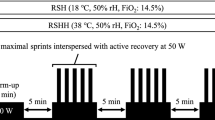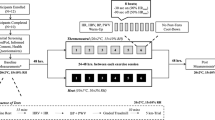Abstract
The purpose of this study was to investigate the effects of acute heat exposure at thermal balance on high-intensity performance during sprint cycle exercise. Nine healthy male subjects were tested in three different, well-controlled environments in an environmental chamber: T (22°C, 65% RH), H1 (30°C, 55% RH) and H2 (35°C, 62% RH), each test being carried out on a different day following a randomized sequence. After 30 min of exposure to the set environment, subjects performed the 30-s sprint cycle exercise. Heart rate, rectal and skin temperatures were measured prior to exercise, at rest, before and after environmental exposure, and after exercise. There were no differences in subjects’ core temperature or heart rate prior to exercise. However, skin temperature was significantly higher in hot trials compared with the control throughout the experimental session (P < 0.05). Peak power was significantly higher in the hot environments compared with the control. Mean power was higher only in H2 compared with T (P < 0.05). This difference in power output was the consequence of a faster pedaling cadence in the hot trials (P < 0.05). Plasma ammonia was higher in the hot trials versus control at 4 min post-sprint. No differences in blood lactate levels at 3 min post-sprint were observed between tests. The results of this study suggest that the exposure to hot environment caused an improvement in power output for a single 30-s sprint. This increase in power output was associated with an elevation in plasma ammonia suggestive of an increase in adenine nucleotide loss.




Similar content being viewed by others
References
ACSM Position Stand (1995) Guideline for exercise testing and prescription. William & Wilkins, Baltimore
ACSM Position Stand (1996) Exercise and fluid replacement. Med Sci Sports Exerc 28:1–12
Asmussen E, Boje O (1945) Body temperature and capacity for work. Acta Physiol Scand 10:1–22
Backx K, Mc Naughton L, Crickmore L, Palmer G, Carlisle A (2000) Effects of differing heat and humidity on the performance and recovery from multiple high intensity, intermittent exercise bouts. Int J Sports Med 21:400–405
Ball D, Burrows C, Sargeant AJ (1999) Human power output during repeated sprint cycle exercise—the influence of thermal stress. Eur J Appl Physiol 79:360–366
Bar-Or O (1987) The Wingate Anaerobic test: an update on methodology, reliability and validity. Int J Sports Med 4:381–394
Brenner IKM, Zamecnik J, Shek PN, Shephard RJ (1997) The impact of heat exposure and repeated exercise on circulating stress hormones. Eur J Appl Physiol 76:445–454
Brozek J, Grande F, Anderson T, Keys A (1963) Densiometric analysis of body composition: revision of some quantitative assumptions. Ann New York Acad Sci 110:113–140
Clark RP, Edholm OG (1985) Man and his thermal environment.1st ed. Edward Arnold, London
Davies C, Young K (1983) Effect of temperature on muscle energy metabolism and endurance during successive isometric contractions, sustained to fatigue, of the quadriceps muscle in man. J Physiol 220:335–352
Dotan R, Bar-Or O (1980) Climatic heat stress and performance in the Wingate Anaerobic test. Eur J Appl Physiol 44:237–243
Dotan R, Bar-Or O (1983) Load optimization for the Wingate Anaerobic test. Eur J Appl Physiol 51:409–417
Drust B, Rasmussen P, Mohr M, Nielsen B, Nybo L (2005) Elevations in core and muscle temperature impairs repeated sprint performance. Acta Physiol Scand 183:181–190
Falk B, Radom-Isaac S, Hoffman JR, Wang Y, Yarom Y, Magazanik A, Weinstein Y (1998) The effect of heat exposure on performance of and recovery from high-intensity, intermittent exercise. Int J Sports Med 19:1–6
Gray S, Nimmo M (2001) Effects of active, passive or no warm-up on metabolism and performance during high-intensity exercise. J Sports Sci 19:693–700
Haymes EM, Wells CL (1986) Environment and human performance. Human Kinetics Publishers, Inc., Champaign
Hoffman JR, Falk B, Radom-Isaac S, Weinstein Y, Magazanik A, Wang Y, Yarom Y (1997) The effect of environmental temperature on testosterone and cortisol responses to high intensity, intermittent exercise in humans. Eur J Appl Physiol 75:83–87
Hue O, Coman F, Blonc S, Hertogh C (2003) Effect of tropical climate on performance during repeated jump-and-reach tests. J Sports Med Phys Fitness 43:475–480
Jackson AS, Pollock ML (1978) Genra1ized equations for predicting body density of men. Br J Nutr 40:497–504
Karatzaferi C, Haan A, van Mechelen W, Sargeant AJ (2001) Metabolic changes in single human muscle fibres during brief maximal exercise. Exp Physiol 86:411–415
Lakomy HKA (1986) Measurement of work and power output using friction-loaded cycle ergometers. Ergonomics 29:509–517
Linnane DM, Bracken RM, Brooks S, Cox VM, Ball D (2004) Effects of hyperthermia on the metabolic responses to repeated high-intensity exercise. Eur J Appl Physiol 93:159–166
Luck JM, Thacker G, Marrack J (1925) Ammonia in the blood of epileptics. Br J Exp Pathol 6:276–279
Pandolf KB, Sawka MN, Gonzalez RR (1986) Human performance physiology and environmental medicine at terrestrial extremes. Cooper Publishing Group, Massachusetts
Powers SK, Howley ET, Cox R (1982) A differential catecholamine response during prolonged exercise and passive heating. Med Sci Sports Exerc 14:435–439
Ramanathan NL (1964) A new weighting system for mean surface temperature of the human body. J Appl Physiol 19:531–533
Romanovsky AA, Ivanov AI, Shimansky YP (2002) Selected contribution: ambient temperature for experiments in rats: a new method for determining the zone of thermal neutrality. J Appl Physiol 92:2667–2679
Rotstein A, Falk B, Einbinder M, Zigel L (1998) Changes in plasma volume following intermittent exercise in neutral and hot environmental conditions. J Sports Med Phys Fitness 38:24–29
Rowell LB (1974) Human cardiovascular adjustments to exercise and thermal stress. Physiol Rev 54:75–159
Sargeant AJ (1987) Effect of muscle temperature on leg extension force and short term power output in humans. Eur J Appl Physiol 56:693–698
Vandewalle H, Péres G, Monod H (1987) Standard anaerobic exercise test. Sports Med 04:268–289
Webb P (1992) Temperatures of skin, subcutaneous tissue, muscle and core in resting men in cold, comfortable and hot conditions. Eur J Appl Physiol 64:471–476
Acknowledgments
The authors are grateful to CNPq, CAPES, and FAPEMIG for financial support. We record our gratitude to Maria Aparecida Vasconcelos Faria for her technical assistance. We also thank Dr. Leszek Szmuchrowski who kindly allowed us to use the cycle ergometer as well as the computer with MEC model software.
Author information
Authors and Affiliations
Corresponding author
Rights and permissions
About this article
Cite this article
Lacerda, A.C.R., Gripp, F., Rodrigues, L.O.C. et al. Acute heat exposure increases high-intensity performance during sprint cycle exercise. Eur J Appl Physiol 99, 87–93 (2007). https://doi.org/10.1007/s00421-006-0329-z
Accepted:
Published:
Issue Date:
DOI: https://doi.org/10.1007/s00421-006-0329-z




